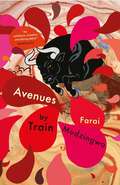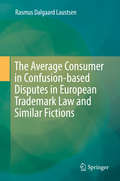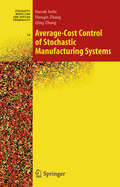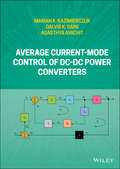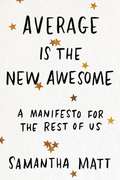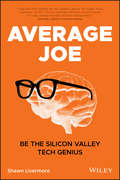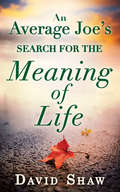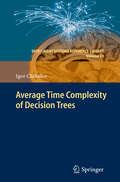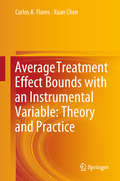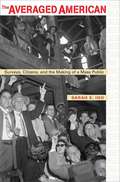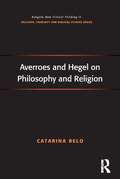- Table View
- List View
Avenues of Participation: Family, Politics, and Networks in Urban Quarters of Cairo (Princeton Studies in Muslim Politics #54)
by Diane SingermanIntentionally excluded from formal politics in authoritarian states by reigning elites, do the common people have concrete ways of achieving community objectives? Contrary to conventional wisdom, this book demonstrates that they do. Focusing on the political life of the sha'b (or popular classes) in Cairo, Diane Singerman shows how men and women develop creative and effective strategies to accomplish shared goals, despite the dominant forces ranged against them. Starting at the household level in one densely populated neighborhood of Cairo, Singerman examines communal patterns of allocation, distribution, and decision-making. Combining the institutional focus of political science with the sensitivities of anthropology, she uncovers a system of informal networks, supported by an informal economy, that constitutes another layer of collective institutions within Egypt and allows excluded groups to pursue their interests.Avenues of Participation traces this informal system from its grounding in the family to its influence on the larger polity. Discussing the role of these networks in meeting fundamental needs in the community--such as earning a living, reproducing the family, saving and investing money, and coping with the bureaucracy--Singerman demonstrates the surprising power these "excluded" people wield. While the government has reduced politics to the realm of distribution to protect itself from challenges, she argues that the popular classes in Cairo, as consumers of goods and services, have turned exploiting the government into a fine art.
Average Case Analysis of Algorithms on Sequences (Wiley Series in Discrete Mathematics and Optimization #50)
by Wojciech SzpankowskiA timely book on a topic that has witnessed a surge of interest over the last decade, owing in part to several novel applications, most notably in data compression and computational molecular biology. It describes methods employed in average case analysis of algorithms, combining both analytical and probabilistic tools in a single volume. * Tools are illustrated through problems on words with applications to molecular biology, data compression, security, and pattern matching. * Includes chapters on algorithms and data structures on words, probabilistic and analytical models, inclusion-exclusion principles, first and second moment methods, subadditive ergodic theorem and large deviations, elements of information theory, generating functions, complex asymptotic methods, Mellin transform and its applications, and analytic poissonization and depoissonization. * Written by an established researcher with a strong international reputation in the field.
Average-Case Analysis of Numerical Problems (Lecture Notes in Mathematics #1733)
by Klaus RitterThe average-case analysis of numerical problems is the counterpart of the more traditional worst-case approach. The analysis of average error and cost leads to new insight on numerical problems as well as to new algorithms. The book provides a survey of results that were mainly obtained during the last 10 years and also contains new results. The problems under consideration include approximation/optimal recovery and numerical integration of univariate and multivariate functions as well as zero-finding and global optimization. Background material, e.g. on reproducing kernel Hilbert spaces and random fields, is provided.
The Average Consumer in Confusion-based Disputes in European Trademark Law and Similar Fictions
by Rasmus Dalgaard LaustsenThis book contends that, with regard to the likelihood of confusion standard, European trademark law applies the average consumer incoherently and inconsistently. To test this proposal, it presents an analysis of the horizontal and vertical level of harmonization of the average consumer. The horizontal part focuses on similar fictions in areas of law adjacent to European trademark law (and in economics), and the average consumer in unfair competition law. The vertical part focuses on European trademark law, represented mainly by EU trademark law, and the trademark laws of the UK, Sweden, Denmark and Norway. The book provides readers with a better understanding of key aspects of European trademark law (the average consumer applied as part of the likelihood of confusion standard) and combines relevant law and practices with theoretical content and other related areas of law (and economics). Accordingly, it is an asset for policymakers and practitioners, as well as general readers with an interest in intellectual property law and theory.
Average-Cost Control of Stochastic Manufacturing Systems (Stochastic Modelling and Applied Probability #54)
by Suresh P. Sethi Han-Qin Zhang Qing ZhangThis book articulates a new theory that shows that hierarchical decision making can in fact lead to a near optimization of system goals. The material in the book cuts across disciplines. It will appeal to graduate students and researchers in applied mathematics, operations management, operations research, and system and control theory.
Average Current-Mode Control of DC-DC Power Converters
by Marian K. Kazimierczuk Dalvir K. Saini Agasthya AyachitAVERAGE CURRENT-MODE CONTROL OF DC-DC POWER CONVERTERS An authoritative one-stop guide to the analysis, design, development, and control of a variety of power converter systems Average Current-Mode Control of DC-DC Power Converters provides comprehensive and up-to-date information about average current-mode control (ACMC) of pulse-width modulated (PWM) dc-dc converters. This invaluable one-stop resource covers both fundamental and state-of-the-art techniques in average current-mode control of power electronic converters???featuring novel small-signal models of non-isolated and isolated converter topologies with joint and disjoint switching elements and coverage of frequency and time domain analysis of controlled circuits. The authors employ a systematic theoretical framework supported by step-by-step derivations, design procedures for measuring transfer functions, challenging end-of-chapter problems, easy-to-follow diagrams and illustrations, numerous examples for different power supply specifications, and practical tips for developing power-stage small-signal models using circuit-averaging techniques. The text addresses all essential aspects of modeling, design, analysis, and simulation of average current-mode control of power converter topologies, such as buck, boost, buck-boost, and flyback converters in operating continuous-conduction mode (CCM). Bridging the gap between fundamental modeling methods and their application in a variety of switched-mode power supplies, this book: Discusses the development of small-signal models and transfer functions related to the inner current and outer voltage loops Analyzes inner current loops with average current-mode control and describes their dynamic characteristics Presents dynamic properties of the poles and zeros, time-domain responses of the control circuits, and comparison of relevant modeling techniques Contains a detailed chapter on the analysis and design of control circuits in time-domain and frequency-domain Provides techniques required to produce professional MATLAB plots and schematics for circuit simulations, including example MATLAB codes for the complete design of PWM buck, boost, buck-boost, and flyback DC-DC converters Includes appendices with design equations for steady-state operation in CCM for power converters, parameters of commonly used power MOSFETs and diodes, SPICE models of selected MOSFETs and diodes, simulation tools including introductions to SPICE, MATLAB, and SABER, and MATLAB codes for transfer functions and transient responses Average Current-Mode Control of DC-DC Power Converters is a must-have reference and guide for researchers, advanced graduate students, and instructors in the area of power electronics, and for practicing engineers and scientists specializing in advanced circuit modeling methods for various converters at different operating conditions.
Average Current-Mode Control of DC-DC Power Converters
by Marian K. Kazimierczuk Dalvir K. Saini Agasthya AyachitAVERAGE CURRENT-MODE CONTROL OF DC-DC POWER CONVERTERS An authoritative one-stop guide to the analysis, design, development, and control of a variety of power converter systems Average Current-Mode Control of DC-DC Power Converters provides comprehensive and up-to-date information about average current-mode control (ACMC) of pulse-width modulated (PWM) dc-dc converters. This invaluable one-stop resource covers both fundamental and state-of-the-art techniques in average current-mode control of power electronic converters???featuring novel small-signal models of non-isolated and isolated converter topologies with joint and disjoint switching elements and coverage of frequency and time domain analysis of controlled circuits. The authors employ a systematic theoretical framework supported by step-by-step derivations, design procedures for measuring transfer functions, challenging end-of-chapter problems, easy-to-follow diagrams and illustrations, numerous examples for different power supply specifications, and practical tips for developing power-stage small-signal models using circuit-averaging techniques. The text addresses all essential aspects of modeling, design, analysis, and simulation of average current-mode control of power converter topologies, such as buck, boost, buck-boost, and flyback converters in operating continuous-conduction mode (CCM). Bridging the gap between fundamental modeling methods and their application in a variety of switched-mode power supplies, this book: Discusses the development of small-signal models and transfer functions related to the inner current and outer voltage loops Analyzes inner current loops with average current-mode control and describes their dynamic characteristics Presents dynamic properties of the poles and zeros, time-domain responses of the control circuits, and comparison of relevant modeling techniques Contains a detailed chapter on the analysis and design of control circuits in time-domain and frequency-domain Provides techniques required to produce professional MATLAB plots and schematics for circuit simulations, including example MATLAB codes for the complete design of PWM buck, boost, buck-boost, and flyback DC-DC converters Includes appendices with design equations for steady-state operation in CCM for power converters, parameters of commonly used power MOSFETs and diodes, SPICE models of selected MOSFETs and diodes, simulation tools including introductions to SPICE, MATLAB, and SABER, and MATLAB codes for transfer functions and transient responses Average Current-Mode Control of DC-DC Power Converters is a must-have reference and guide for researchers, advanced graduate students, and instructors in the area of power electronics, and for practicing engineers and scientists specializing in advanced circuit modeling methods for various converters at different operating conditions.
Average is the New Awesome: A Manifesto for the Rest of Us
by Samantha MattA celebration of ordinary awesomeness, for all of us who were told "You can do anything!" and then found out we actually can'tCrappy homes, lame love lives, getting passed over for a great job (again)--not what we expected for our adulthoods. Americans tell their children you can become anything! But let's face it--most of us can't. Sure, some of our peers go on to become astronauts or billionaires. But most of us don't. In Average Is the New Awesome, Samantha Matt offers encouragement to us regular humans. Full of hilarious stories and insightful advice, this is a manifesto for ordinary awesomeness--for the beauty that can be found when we acknowledge that good enough really is good enough, and that greatness is ours to define.
Average Joe: Be the Silicon Valley Tech Genius
by Shawn LivermoreThe book covers numerous tech entrepreneurial founders and software developers, and the exciting brands or products that they created. It goes deep on a handful of them, narrowly divulging exactly how a few software developers and startup founders created breakthrough tech products like Gmail, Dropbox, Ring, Snapchat, Bitcoin, Groupon, and more. It highlights and unpacks the general hero-worship that the media and our own minds practice about tech founders and tech entrepreneurs. This idealization of tech success can create a paradox, preventing average tech professionals from their own successful journeys. This book provides hard evidence that anyone in tech can create, and anyone on the peripheral of tech can break through to the center where innovation, creativity, and opportunity meet. The anecdotes, stories, evidence, facts, arguments, logic, principles, and techniques provided in this book have helped individuals and businesses engage in slow creation cycles, improve the morale of their development teams, and increased their delivery potential of their technology solutions overall. Average Joe covers: Genius - The systematic deconstruction and debunking of the commonly held assumptions in the tech industry around supreme intelligence, and how that intelligence has been worshipped and sought after, despite the facts. Slow Creation - How to force-manufacture creative ideation. How conscious and subconscious cycles of patterns, details, and secrets can lead to breakthrough innovations, and how those P.D.S. cycles, and systematic mental grappling, can be conjured and repeated on a regular basis. Little-C Creativity - The conscious and miniature moments of epiphany that leak into our active P.D.S. cycles of Slow Creation. Flow - Why it's great, but also - why it's completely unreliable and unnecessary. How to perpetually innovate without relying on a flow state. Team Installation - How teams and companies can engage their employees in Slow Creation to unlock dormant ideas, stir up creative endeavors, and jumpstart fragile ideas into working products. User Manipulation - How tech products are super-charged with tricks, secret techniques, and neural transmitters like Dopamine, Oxytocin, and Cortisol; how those products leverage cognitive mechanisms and psychological techniques to force user adoption and user behaviors. Contrarianism - How oppositional and backward-thinking leaders create brand-new categories and the products which dominate those categories. Showmanship - How tech players have presented their ideas to the world, conjured up magic, manufactured mystique, and presented compelling stories that have captured their audiences. Sustainable Mystique Triad – A simple model for capturing audiences consistently without relying on hype and hustle.
Average Joe: Be the Silicon Valley Tech Genius
by Shawn LivermoreThe book covers numerous tech entrepreneurial founders and software developers, and the exciting brands or products that they created. It goes deep on a handful of them, narrowly divulging exactly how a few software developers and startup founders created breakthrough tech products like Gmail, Dropbox, Ring, Snapchat, Bitcoin, Groupon, and more. It highlights and unpacks the general hero-worship that the media and our own minds practice about tech founders and tech entrepreneurs. This idealization of tech success can create a paradox, preventing average tech professionals from their own successful journeys. This book provides hard evidence that anyone in tech can create, and anyone on the peripheral of tech can break through to the center where innovation, creativity, and opportunity meet. The anecdotes, stories, evidence, facts, arguments, logic, principles, and techniques provided in this book have helped individuals and businesses engage in slow creation cycles, improve the morale of their development teams, and increased their delivery potential of their technology solutions overall. Average Joe covers: Genius - The systematic deconstruction and debunking of the commonly held assumptions in the tech industry around supreme intelligence, and how that intelligence has been worshipped and sought after, despite the facts. Slow Creation - How to force-manufacture creative ideation. How conscious and subconscious cycles of patterns, details, and secrets can lead to breakthrough innovations, and how those P.D.S. cycles, and systematic mental grappling, can be conjured and repeated on a regular basis. Little-C Creativity - The conscious and miniature moments of epiphany that leak into our active P.D.S. cycles of Slow Creation. Flow - Why it's great, but also - why it's completely unreliable and unnecessary. How to perpetually innovate without relying on a flow state. Team Installation - How teams and companies can engage their employees in Slow Creation to unlock dormant ideas, stir up creative endeavors, and jumpstart fragile ideas into working products. User Manipulation - How tech products are super-charged with tricks, secret techniques, and neural transmitters like Dopamine, Oxytocin, and Cortisol; how those products leverage cognitive mechanisms and psychological techniques to force user adoption and user behaviors. Contrarianism - How oppositional and backward-thinking leaders create brand-new categories and the products which dominate those categories. Showmanship - How tech players have presented their ideas to the world, conjured up magic, manufactured mystique, and presented compelling stories that have captured their audiences. Sustainable Mystique Triad – A simple model for capturing audiences consistently without relying on hype and hustle.
An Average Joe's Search For The Meaning Of Life
by David ShawDavid Shaw sees himself as an Average Joe.
Average Time Complexity of Decision Trees (Intelligent Systems Reference Library #21)
by Igor ChikalovDecision tree is a widely used form of representing algorithms and knowledge. Compact data models and fast algorithms require optimization of tree complexity. This book is a research monograph on average time complexity of decision trees. It generalizes several known results and considers a number of new problems. The book contains exact and approximate algorithms for decision tree optimization, and bounds on minimum average time complexity of decision trees. Methods of combinatorics, probability theory and complexity theory are used in the proofs as well as concepts from various branches of discrete mathematics and computer science. The considered applications includethe study of average depth of decision trees for Boolean functions from closed classes, the comparison of results of the performance of greedy heuristics for average depth minimization with optimal decision trees constructed by dynamic programming algorithm,and optimization of decision trees for the corner point recognition problem from computer vision. The book can be interesting for researchers working on time complexity of algorithms and specialists in test theory, rough set theory, logical analysis of data and machine learning.
Average Treatment Effect Bounds with an Instrumental Variable: Theory and Practice
by Carlos A. Flores Xuan ChenThis book reviews recent approaches for partial identification of average treatment effects with instrumental variables in the program evaluation literature, including Manski’s bounds, bounds based on threshold crossing models, and bounds based on the Local Average Treatment Effect (LATE) framework. It compares these bounds across different sets of assumptions, surveys relevant methods to assess the validity of these assumptions, and discusses estimation and inference methods for the bounds. The book also reviews some empirical applications employing bounds in the program evaluation literature. It aims to bridge the gap between the econometric theory on which the different bounds are based and their empirical application to program evaluation.
The Averaged American: Surveys, Citizens, and the Making of a Mass Public
by Sarah E. Igosupports the death penalty, that half of all marriages end in divorce, and that four out of five prefer a particular brand of toothpaste. But remarkably, such data--now woven into our social fabric--became common currency only in the last century. With a bold and sophisticated analysis, Sarah Igo demonstrates the power of scientific surveys to shape Americans' sense of themselves as individuals, members of communities, and citizens of a nation.
Averaging Methods in Nonlinear Dynamical Systems (Applied Mathematical Sciences #59)
by Jan A. Sanders Ferdinand VerhulstIn this book we have developed the asymptotic analysis of nonlinear dynamical systems. We have collected a large number of results, scattered throughout the literature and presented them in a way to illustrate both the underlying common theme, as well as the diversity of problems and solutions. While most of the results are known in the literature, we added new material which we hope will also be of interest to the specialists in this field. The basic theory is discussed in chapters two and three. Improved results are obtained in chapter four in the case of stable limit sets. In chapter five we treat averaging over several angles; here the theory is less standardized, and even in our simplified approach we encounter many open problems. Chapter six deals with the definition of normal form. After making the somewhat philosophical point as to what the right definition should look like, we derive the second order normal form in the Hamiltonian case, using the classical method of generating functions. In chapter seven we treat Hamiltonian systems. The resonances in two degrees of freedom are almost completely analyzed, while we give a survey of results obtained for three degrees of freedom systems. The appendices contain a mix of elementary results, expansions on the theory and research problems.
Averaging Methods in Nonlinear Dynamical Systems (Applied Mathematical Sciences #59)
by Jan A. Sanders Ferdinand Verhulst James MurdockPerturbation theory and in particular normal form theory has shown strong growth in recent decades. This book is a drastic revision of the first edition of the averaging book. The updated chapters represent new insights in averaging, in particular its relation with dynamical systems and the theory of normal forms. Also new are survey appendices on invariant manifolds. One of the most striking features of the book is the collection of examples, which range from the very simple to some that are elaborate, realistic, and of considerable practical importance. Most of them are presented in careful detail and are illustrated with illuminating diagrams.
Averroes and Hegel on Philosophy and Religion (Routledge New Critical Thinking in Religion, Theology and Biblical Studies)
by Catarina BeloComparing Averroes’ and Hegel’s positions on the relation between philosophy and religion, this book explores the theme of the authorities of faith and reason, and the origin of truth, in a medieval Islamic and a modern Christian context respectively. Through an in-depth analysis of Averroes’ and Hegel’s parallel views on the nature of philosophical and religious discourse, Belo presents new insights into their perspectives on the relation between philosophical knowledge and religious knowledge, and the differences between philosophy and religion. In addition, Belo explores particular works which have not yet been studied by modern scholarship.
Averroes and Hegel on Philosophy and Religion (Routledge New Critical Thinking in Religion, Theology and Biblical Studies)
by Catarina BeloComparing Averroes’ and Hegel’s positions on the relation between philosophy and religion, this book explores the theme of the authorities of faith and reason, and the origin of truth, in a medieval Islamic and a modern Christian context respectively. Through an in-depth analysis of Averroes’ and Hegel’s parallel views on the nature of philosophical and religious discourse, Belo presents new insights into their perspectives on the relation between philosophical knowledge and religious knowledge, and the differences between philosophy and religion. In addition, Belo explores particular works which have not yet been studied by modern scholarship.
Averroes and His Philosophy (Curzon Jewish Philosophy Ser.)
by Oliver LeamanDespite his important stature in the history of philosophy, Averroes is a thinker whose work has been left largely unexplored in this century. It is the aim of this book to rectify this omission, and to argue that his philosophical output is of considerable philosophical as well as historical significance.
Averroes and His Philosophy
by Oliver LeamanDespite his important stature in the history of philosophy, Averroes is a thinker whose work has been left largely unexplored in this century. It is the aim of this book to rectify this omission, and to argue that his philosophical output is of considerable philosophical as well as historical significance.
Averroes, Kant and the Origins of the Enlightenment: Reason and Revelation in Arab Thought
by Saud M. TamamyThe twelfth-century philosopher Averroes is often identified by modern Arab thinkers as an early advocate of the Enlightenment. Saud M. S. Al-Tamamy demonstrates that an historical as well as comparative approach to Averroes' thought refutes this widely held assumption. The philosophical doctrine of Averroes is compared with that of the key figure of the Enlightenment in Western thought, Immanuel Kant. By comparing Averroes and Kant, Al-Tamamy evaluates the ideologies of each thinker's work and in particular focuses on their respective political implications on two social groups: the Elite, in Averroes' case, and the Public, in the case of Kant. The book's methodology is at once historical, analytical and communicative, and is especially relevant when so many thinkers - both Western and Middle Eastern - are anxious to find common denominators between the formations of Islamic and Western cultures. It responds to a need for comparative analysis in the field of Averroes studies, and takes on the challenge to uncover the philosopher's influence on the Enlightenment.
Averroes, Kant and the Origins of the Enlightenment: Reason and Revelation in Arab Thought (Library of Middle East History)
by Saud M. TamamyThe twelfth-century philosopher Averroes is often identified by modern Arab thinkers as an early advocate of the Enlightenment. Saud M. S. Al-Tamamy demonstrates that an historical as well as comparative approach to Averroes' thought refutes this widely held assumption. The philosophical doctrine of Averroes is compared with that of the key figure of the Enlightenment in Western thought, Immanuel Kant. By comparing Averroes and Kant, Al-Tamamy evaluates the ideologies of each thinker's work and in particular focuses on their respective political implications on two social groups: the Elite, in Averroes' case, and the Public, in the case of Kant. The book's methodology is at once historical, analytical and communicative, and is especially relevant when so many thinkers - both Western and Middle Eastern - are anxious to find common denominators between the formations of Islamic and Western cultures. It responds to a need for comparative analysis in the field of Averroes studies, and takes on the challenge to uncover the philosopher's influence on the Enlightenment.
Averroes on Intellect: From Aristotelian Origins to Aquinas' Critique
by Stephen R. OgdenAverroes on Intellect provides a detailed analysis of the Muslim philosopher Averroes (Ibn Rushd)'s notorious unicity thesis — the view that there is only one separate and eternal intellect for all human beings. It focuses directly on Averroes' arguments, both from the text of Aristotle's De Anima and, more importantly, his own philosophical arguments in the Long Commentary on the De Anima. Stephen Ogden defends Averroes' interpretation of De Anima using a combination of Greek, Arabic, Latin, and contemporary sources. Yet, Ogden also insists that Averroes is not merely a 'commentator' but an incisive philosopher in his own right. The author thus reconstructs and analyzes Averroes' two most significant independent philosophical arguments, the Determinate Particular Argument and the Unity Argument. Alternative ancient and medieval views are also considered throughout, especially from two important foils before and after Averroes, namely, Avicenna (Ibn Sina) and Thomas Aquinas. Aquinas' most famous and penetrating arguments against the unicity thesis are also addressed. Finally, Ogden considers Averroes' own objections to broader metaphysical views of the soul like Avicenna's and Aquinas', which agree with him on several key points including the immateriality of the intellect and the individuation of human souls by matter, while still diverging on the number and substantial nature of the intellect. The central goal of this book is to provide readers with a single study of Averroes' most pivotal arguments on intellect, consolidating and building on recent scholarship and offering a comprehensive case for his unicity thesis in the wider context of Aristotelian epistemology and metaphysics.
